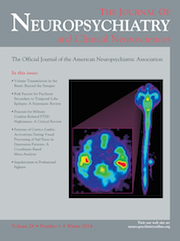Benzodiazepine-Induced Coma in the Treatment of Severe Acute Mania
To the Editor: The management of bipolar disorders remains a considerable challenge in psychiatry, especially when taking into consideration the lifetime prevalence of these debilitating conditions which range from 0.7% to 6% in the general population,1,2 depending on the various clinical criteria, and their impact on functional outcome, underpinned by cognitive impairment and various psychosocial disabilities.3 Mortality is also increased in bipolar patients,4 accounted for both by a higher suicide rate5 and by the occurrence of diverse medical comorbidities such as cardiovascular and respiratory conditions.6 Acute mania remains a crucial characteristic phase of bipolar disorder, and its treatment is of particular interest. Indeed, a recent review has identified 11 pharmacological agents that have proven anti-manic efficacy, but a complete remission of symptoms is rare.7 In refractory and severe cases, electroconvulsive therapy (ECT) is also recommended.8
In September 2011 a 46-year-old woman was admitted in our psychiatric unit for a severe manic episode according to DSM-IV-TR criteria; she presented then with a 10-day history of severe psychomotor agitation, intense flight of ideas, mood-congruent psychotic features, logorrhea, and sleep disturbance, causing a marked functional impairment. She scored 50 on the Young Mania Rating Scale (YMRS).9 Her regular treatment consisted of lithium carbonate (1,000 mg daily), olanzapine (40 mg daily), and cyamemazine (150 mg daily). Her history of bipolar disorder started at the age of 18 with a major depressive episode with psychotic features requiring 8-month hospital care and ECT. She was admitted three other times (1987, 1995, and 2002) for periods ranging from 6 to 8 months for bipolar recurrences. Antipsychotic and mood-stabilizing medication showed partial efficacy on psychomotor agitation only. She had no family history of affective disorder. During the first week after admission, she developed lithium-induced nephrogenic diabetes insipidus, which caused rapid global dehydration. We transferred her to the intensive care unit, where sedation and intubation were needed for appropriate rehydration. All her treatments were stopped. She was given intravenous midazolam (0.07 mg/kg/h) and sufentanil (0.03 μg/kg/h) for 5 days before she was extubated. After recovery, the patient’s manic symptoms had almost disappeared: her mood was stable; the psychomotor agitation vanished; irritability was absent; rate and amount of speech returned to normal. She only presented mild dysarthria, probably caused by lithium, and complete amnesia for the manic episode. The YMRS score was 5 at 1 week after extubation. Lithium carbonate (1,000 mg daily), olanzapine (30 mg daily), and diazepam (40 mg) were reinstated. She stayed at the hospital for a month and could go back home. In November 2012, her mood was stable and no residual symptom had persisted.
Benzodiazepines are not considered a first-line treatment for acute mania, but previous research has recognized a possible anti-manic effect, especially with clonazepam10 and lorazepam.11 Based on the patient’s bipolar history, it is unlikely to consider a spontaneous remission of the manic episode; this provides evidence of a potential anti-manic effect of midazolam. We suggest that this treatment, along with the highly secure environment provided by the intensive care unit, be considered as a first-line option for difficult-to-treat manic symptoms, which would prevent complications such as drug-induced parkinsonism and those associated with psychomotor agitation, and would considerably reduce the length of hospital stay. Midazolam is a benzodiazepine commonly used for anesthetic sedation; its safety is now recognized, and its effects are reproducible.12 We could not find any other report of midazolam use in acute mania in the literature, but its role in prolonging rapid eye movement (REM) latency is known,13 just as ECT does, so is another effective treatment in acute mania. We suggest this effect to have a therapeutic role in acute mania, since REM latency is shortened in mania.14
1 : Revised prevalence estimates of mental disorders in the United States: using a clinical significance criterion to reconcile 2 surveys’ estimates. Arch Gen Psychiatry 2002; 59:115–123Crossref, Medline, Google Scholar
2 : The prevalence and disability of bipolar spectrum disorders in the U.S. population: re-analysis of the ECA database taking into account subthreshold cases. J Affect Disord 2003; 73:123–131Crossref, Medline, Google Scholar
3 : Cognition and disability in bipolar disorder: lessons from schizophrenia research. Bipolar Disord 2010; 12:364–375Crossref, Medline, Google Scholar
4 : Bipolar disorder. Lancet 2002; 359:241–247Crossref, Medline, Google Scholar
5 : Affective disorders and suicide risk: a reexamination. Am J Psychiatry 2000; 157:1925–1932Crossref, Medline, Google Scholar
6 : Excess mortality in bipolar and unipolar disorder in Sweden. Arch Gen Psychiatry 2001; 58:844–850Crossref, Medline, Google Scholar
7 : The pharmacologic treatment of bipolar disorder. J Clin Psychiatry 2011; 72:704–715Crossref, Medline, Google Scholar
8 : Electroconvulsive therapy of acute manic episodes: a review of 50 years’ experience. Am J Psychiatry 1994; 151:169–176Crossref, Medline, Google Scholar
9 : A rating scale for mania: reliability, validity and sensitivity. Br J Psychiatry 1978; 133:429–435Crossref, Medline, Google Scholar
10 : Antimanic effect of clonazepam. Biol Psychiatry 1983; 18:451–466Medline, Google Scholar
11 : Lorazepam in resistant mania. Lancet 1986; 1:510Medline, Google Scholar
12 : An investigation of the safety of midazolam use in hospital. Pharmacoepidemiol Drug Saf 1997; 6:79–87Crossref, Medline, Google Scholar
13 : Effect of midazolam on sleep. Br J Clin Pharmacol 1983; 16(Suppl 1):81S–86SCrossref, Medline, Google Scholar
14 : Electroencephalographic sleep in mania. Arch Gen Psychiatry 1988; 45:267–273Crossref, Medline, Google Scholar



